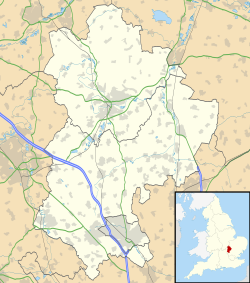
Bedfordshire is an English ceremonial county which lies between approximately 25 miles and 55 miles north of central London.
Manshead was a hundred of Bedfordshire in England. It covered an area in the south-west of the county stretching from Salford to Studham and from Leighton Buzzard to Houghton Regis and Dunstable.

Dunstable is a market town and civil parish in Bedfordshire, England, east of the Chiltern Hills, 30 miles north of London. There are several steep chalk escarpments, most noticeable when approaching Dunstable from the north. Dunstable is the fourth largest town in Bedfordshire and along with Houghton Regis forms the westernmost part of the Luton/Dunstable urban area.
Ruxox Cell was a moated chapel, or monastic cell, established in the twelfth century in the parish of Flitwick in Bedfordshire, England. Situated on the east side of the village of Ruxox, it was granted to the Augustinian priory of Dunstable by Philip de Sanvill, Lord of Flitwick, c. 1170. The grant was confirmed by William, Earl of Aumale, and his wife, Hawise, who was Countess of Aumale in her own right. It was dedicated to St. Nicholas by Robert de Chesney, bishop of Lincoln. Priors from Dunstable would sometimes retire to Roxux.

Derby Dominican Priory, also known as Derby Black Friary, or Blackfriars, Derby, was a Dominican priory situated in the town of Derby, England. It was also named in different sources as a friary, monastery and convent, but was officially a priory as it was headed by a prior and the Dominican Order calls all their houses Priories. The "Black" came from the colour of the mantles worn by the friars of the order.

Blackfriars Priory was a medieval Dominican priory dating back to the thirteenth century. The remains of the priory, located in Hereford, England, consist of monastery ruins, a cemetery, and a stone preaching cross. The ruins are surrounded by a rose garden established by the local community in 1964.
Guildford Friary was a medieval monastic house in Guildford, Surrey, England. It was founded c. 1275 by Eleanor of Provence, wife of Henry III and occupied a site of around 10 acres (4.0 ha) on the east side of the River Wey. It was dissolved in 1537.

Ipswich Blackfriars was a medieval religious house of Friars-preachers (Dominicans) in the town of Ipswich, Suffolk, England, founded in 1263 by King Henry III and dissolved in 1538. It was the second of the three mendicant communities established in the town, the first being the Greyfriars, a house of Franciscan Friars Minors, and the third the Ipswich Whitefriars of c. 1278–79. The Blackfriars were under the Visitation of Cambridge.

Blackfriars Leicester, also known as St Clement's Church, Leicester and St Clement's Priory, Leicester, is a former priory of the Order of Preachers in the city of Leicester in Leicestershire, England. It is also the name of a former civic parish, and a neighbourhood in the city built on and around the site of the old priory.

The Augustinian Friary of the Most Holy Trinity was an Augustinian Roman Catholic Priory, founded c. 1259, by the family of Talbot on the south bank of the river, in what is now Crow Street, Dublin. At the time the priory was built, it was just outside the city walls. The Friary most likely followed the design of the parent priory Clare Priory in the town of Clare, Suffolk (England). The Friary was suppressed in 1540 when it was described as a "church with belfry, a hall and dormitory". The friars continued to operate in secret within the city. and there are several mentions of them in the city archives until the late 1700s when they consecrated a new church.

Totternhoe Roman villa is on Church Farm, Church Road, in Totternhoe, Bedfordshire, England. No sign of it is now visible, as it has been filled in and grassed over.

Strade Abbey is a former Franciscan/Dominican monastery and National Monument located in County Mayo, Ireland.
Charmian Catherine Woodfield was a British archaeologist.

Kinalehin Friary, originally a medieval charterhouse or Carthusian monastery and later a Franciscan friary, is a National Monument located in County Galway, Ireland.
Blackfriars was a priory of the Order of Preachers in King's Lynn, Norfolk, England, established in the 1250s and dissolved in 1538. The name Blackfriars comes from the black cappa (cloak) and hood Dominican Friars wear over their white habits during the winter and when outside the cloister.











